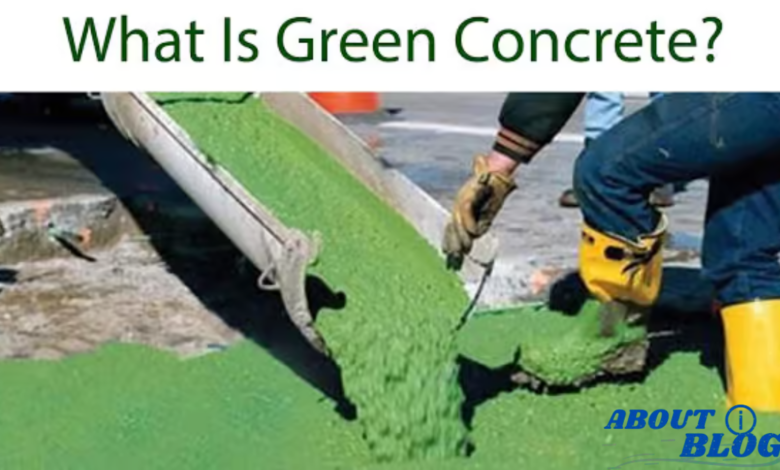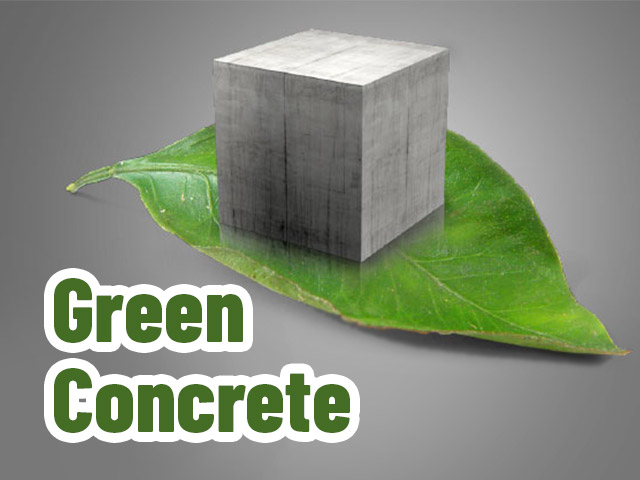Green Concrete: The Future of Sustainable Construction

In recent years, the construction industry has transformed, Green concrete with sustainability at the forefront. One of the most innovative solutions to reduce the environmental impact of construction is the development of green concrete. But what exactly is green concrete, and why is it becoming such a popular choice in the industry? This article will take you on an in-depth exploration of green concrete, highlighting its benefits, applications, and potential in shaping a more eco-friendly future.
What is Green Concrete?

Green concrete is a term used to describe concrete that is produced using sustainable practices, incorporating alternative materials to reduce its environmental impact. Unlike traditional concrete, which heavily relies on cement—a significant contributor to carbon emissions—green concrete uses recycled or alternative materials to achieve the same strength and durability while minimizing the negative effects on the planet.
Key Features of Green Concrete
- Reduced Carbon Footprint: Uses less cement and more sustainable materials.
- Recycled Content: Often made from industrial by-products like fly ash or slag.
- Energy Efficiency: Uses less energy during production.
- Longer Lifespan: Designed for better durability, reducing the need for repairs.
Green concrete aims to make construction more eco-friendly without compromising on quality or strength.
The Environmental Impact of Traditional Concrete
Traditional concrete, while essential in the construction industry, comes with a hefty environmental price tag. The production of cement—the primary ingredient in concrete—contributes significantly to global carbon emissions. Here’s why:
The Environmental Cost of Cement
- High Carbon Emissions: Cement production accounts for approximately 8% of global CO2 emissions.
- Mining of Raw Materials: Quarrying materials like limestone can lead to soil degradation and loss of biodiversity.
- Energy Consumption: Cement production is energy-intensive, often relying on fossil fuels.
Given these environmental concerns, the construction industry is actively seeking alternatives, and green concrete is emerging as a viable solution.
How is Green Concrete Made?
The production of green concrete involves incorporating environmentally friendly materials to replace or reduce the use of traditional cement. Some of these materials include:
Key Ingredients in Green Concrete
- Fly Ash: A by-product of coal combustion, fly ash is used to replace a portion of the cement, reducing the environmental impact of concrete production.
- Slag Cement: Made from the waste products of steel manufacturing, slag cement is another alternative that reduces the need for traditional cement.
- Recycled Aggregates: These are materials like crushed concrete or recycled glass that replace traditional aggregates like sand and gravel.
- Rice Husk Ash: A sustainable alternative to cement, produced from burning rice husks.
By using these sustainable materials, green concrete significantly reduces its carbon footprint while maintaining the strength and durability of conventional concrete.
Benefits of Green Concrete
The shift towards green concrete offers numerous benefits for both the environment and the construction industry. Below are some of the key advantages:
Environmental Benefits
- Reduced Carbon Emissions: By replacing traditional cement with alternative materials, green concrete helps reduce carbon dioxide emissions.
- Lower Energy Use: The production of green concrete consumes less energy compared to conventional concrete.
- Less Waste: Green concrete often incorporates recycled materials, reducing the amount of waste sent to landfills.
Economic and Practical Benefits
- Cost-Effectiveness: Green concrete can be more affordable, especially when using local waste products as materials.
- Durability: It has been shown to last longer, requiring less maintenance and reducing long-term repair costs.
- Improved Insulation: Some green concrete formulations offer better thermal insulation properties, potentially lowering heating and cooling costs in buildings.
Incorporating green concrete not only makes construction more sustainable but also offers financial and practical advantages.
Applications of Green Concrete
Green concrete is a versatile material with a wide range of applications in the construction industry. Some of the key uses include:
Where Green Concrete is Used
- Building Foundations: Green concrete’s strength and durability make it ideal for building strong, eco-friendly foundations.
- Roads and Pavements: Green concrete can be used in constructing roads, bridges, and other infrastructure, significantly reducing their environmental impact.
- Energy-Efficient Buildings: The improved thermal insulation properties of green concrete make it perfect for energy-efficient structures.
- Urban Infrastructure: Green concrete is becoming increasingly popular in the development of urban spaces, such as parks, sidewalks, and plazas.
As more industries turn to sustainable solutions, green concrete continues to find its place in a variety of construction projects.
Green Concrete vs. Traditional Concrete
To fully understand the advantages of green concrete, it’s important to compare it with traditional concrete. Here’s a detailed breakdown:
FeatureGreen ConcreteTraditional Concrete
Carbon Emissions Low emissions due to alternative materials High emissions due to cement production
Material Usage Uses recycled materials and industrial by-products Primarily uses raw materials like limestone
Energy Consumption Reduced energy consumption High energy demand during production
Durability Longer lifespan with reduced maintenance Requires more frequent repairs
Cost Can be more affordable depending on materials Generally more expensive due to high cement cost
As shown, green concrete outperforms traditional concrete in several areas, especially in terms of sustainability and long-term cost-effectiveness.
Challenges and Limitations of Green Concrete
While green concrete offers numerous advantages, it is not without its challenges. Some of the limitations include:
Potential Drawbacks
- Availability of Materials: Some sustainable materials, like fly ash, may not be available in all regions.
- Initial Research and Development Costs: Developing new formulas and conducting research to optimize green concrete can be costly.
- Standardization Issues: Green concrete is still a relatively new technology, and there is a lack of standardization in its production and use.
Despite these challenges, the potential benefits of green concrete far outweigh the drawbacks, making it an exciting area for innovation in construction.
The Future of Green Concrete
As the demand for sustainable construction practices continues to rise, the future of green concrete looks bright. Researchers are constantly working on new materials and technologies that can further reduce its environmental impact. Here are a few developments to watch for:
Innovations in Green Concrete
- Self-Healing Concrete: This type of concrete can repair cracks and damage on its own, extending its lifespan even further.
- Carbon Capture Technology: Some researchers are working on ways to capture and store carbon during concrete production, further reducing its environmental impact.
- Better Recycling Techniques: Improved methods for recycling materials into concrete could help make green concrete even more sustainable.
The future of green concrete holds endless possibilities, and it could very well be the foundation for the next generation of eco-friendly buildings and infrastructure.
Conclusion: Embracing Green Concrete for a Sustainable Future
In conclusion, green concrete is a promising alternative to traditional concrete, offering a more sustainable and environmentally friendly option for construction projects. By reducing carbon emissions, minimizing waste, and utilizing recycled materials, green concrete contributes to a cleaner and greener planet.
As more industries recognize the importance of sustainability, the use of green concrete is bound to grow. Whether you’re a builder, developer, or simply someone passionate about sustainability, embracing green concrete is a step in the right direction for a more eco-conscious future.





